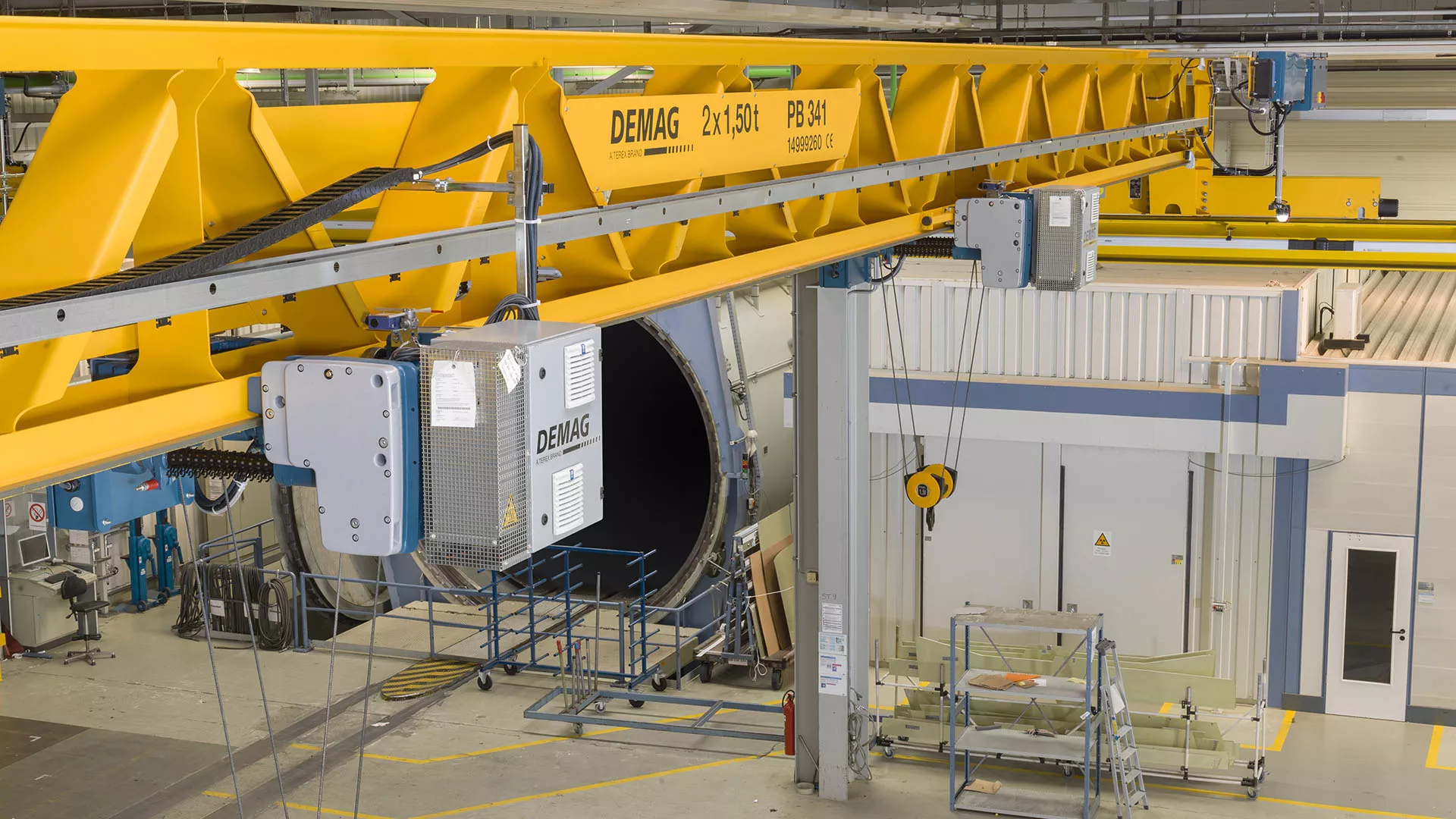
First choice: cranes
Premium AEROTEC
Overhead material transport
The aviation industry supplier Premium AEROTEC relies on two new Demag V-type cranes from Terex Material Handling in the manufacture of and for transporting aluminum skin plates for aircraft fuselage segments. A series of benefits offered by this generation of cranes included a decisive factor: the low crane deadweight reduces loads on the building structure and provides even more scope for handling loads.
Aluminum shell sections, fuselage mid sections and loading flaps – Premium AEROTEC manufactures aircraft components at five locations in Germany and Romania. The plant in Nordenham in the state of Lower Saxony, Germany, is the world’s most advanced facility for the manufacture of integrated fuselage shells.
The plant specializes in the manufacture of integrated aircraft shells made of aluminum, which are used for the construction of complete fuselage structures, mainly for Airbus aircraft. The plant turns out more than 5,000 fuselage shells every year. The Nordenham plant is also a leader in the manufacture of fuselage structures made of carbon fiber composites, which are used for the Airbus A350 XWB program, for example.
Nordenham forms one of the starting points for the Airbus A320 and A380 families of aircraft. Here, the aluminum skin plates are produced, which form the basis for the subsequent fuselage sections. These panels are first placed in autoclave molds. Stringers are then bonded to them and a vacuum film is applied. This is then followed by a bonding process, which takes place in special pressure-tight kilns, which are called autoclaves.
First choice: cranes
To lift the individual component carriers with the fuselage sections into the autoclaves, and to transport them to an ultrasonic test facility after the bonding process, Premium AEROTEC utilizes a crane as an overhead handling device. The empty component carriers are also cleared away into stacks by cranes when the process is finished. Until now, these tasks were performed by a double-girder overhead traveling crane that had box-section girders and was equipped with four 1.1 t hoist units. “The loads that this crane had to lift several times every day weighed around 4.1 tons. This meant that we were always working close to the limit”, explains Andreas Voge, who is responsible for assembly system factory planning at Premium AEROTEC. “And that took place around the clock, six days a week.”
When the double-girder overhead traveling crane, which dates back to 1961, came up for refurbishment, planning for a new investment became more specific. “That would have been very expensive, particularly in view of the fact that the four hoist units were also soon due for a general overhaul. And that is why we quickly realized that we needed a new crane”, adds Fred Maas, who co-ordinates materials handling equipment delivered by external suppliers at Premium AEROTEC. However, that was not all. In order to make the production processes more flexible, Premium AERORTEC planned to invest in two single-girder overhead traveling cranes that can operate separately, as well as in tandem. Due to the load-bearing capacity of the building structure, the two new cranes were not allowed to exceed the deadweight of the existing crane and, therefore, their wheel loads were not to be any higher. This condition was met by the two box-section girder cranes that were initially specified. Andreas Voge explains: “Our aim was also no longer to work close to the limit with the new cranes. For that reason, we looked for a way to increase the load capacity of the cranes.”
Impressive crane concept
The launch of a completely new crane girder with the Demag V-type crane came at exactly the right time. This solution satisfied all of the conditions, particularly in view of its reduced deadweight. “We quickly saw that the V-type crane concept was the right solution”, agree Andreas Voge and Fred Maas in retrospect. “Our main requirement to save weight and, consequently, to reduce the load exerted on the building structure, was met by this new type of crane. We then increased the rated load capacity by a few hundred kilograms. That means that we can now handle more parts than with the old crane, and we are better prepared for future developments.”
Manufacturing aircraft components with V-type cranes
At its production plant in Nordenham, Premium AEROTEC now operates two Demag V-type cranes that have spans of 24 m and are each equipped with two Demag DR-Pro 1.5 t rope hoists. “By using two cranes, we are now much more flexible”, continues Andreas Voge. The cranes can also perform various transport tasks along the 115 m-long crane runway. However, they are still mainly used to serve the autoclaves. To do this, both cranes work in tandem and the four hoist units operate under synchronized control. Andreas Voge: “Switching over to tandem mode is part of the daily routine for our crane operators. To do this, both V-type cranes are moved to within four meters of each other. Control is then switched over virtually by pressing a button.”
An additional benefit of the V-type crane was quickly seen in the course of daily operation: “Thanks to the crane’s reduced oscillation characteristics, the jigs can be picked up and deposited in a more controlled way. Also thanks to the inverter controls, loads can be handled very precisely.” Positioning of the sensitive aircraft components can be controlled with ease: simple switch-over to tandem operation as well as the possibility to position components gently and carefully resulted in swift acceptance of the new cranes. Fred Maas comments: “Our colleagues who work with the two cranes every day are now highly satisfied with them. They really like the travel characteristics, the dynamic performance and ease of control.”
Fast installation and commissioning
The break in production over the long Easter weekend was utilized to remove the old crane and install the new crane systems. Thanks to an experienced Demag Service installation team, the double-girder overhead traveling crane was taken off the runway and the two new cranes were installed within a few hours on the Friday. Following the commissioning work, the installation was given statutory approval by the inspector on the Saturday, which meant that the cranes were ready for operation in the first shift after the weekend.
Reduced effort, improved safety
A further aspect was essential for Premium AEROTEC: safety during regular operation. This is an inherent feature of the Demag V-type girder design. Fred Maas explains: “This new type of crane offers another benefit: thanks to its V-type structure and vertical struts, the weld seams can be checked at a glance. The regular visual inspections can be completed within a quarter of an hour.”
Higher load capacity, reduced oscillations, simple switch-over to tandem operation and improved safety: Premium AEROTEC is impressed with the new Demag V-type girder – and already has plans for the future: “The cranes have been operating reliably around the clock since they entered service. We are sure that even more V-type cranes will be used in our production facilities.”





